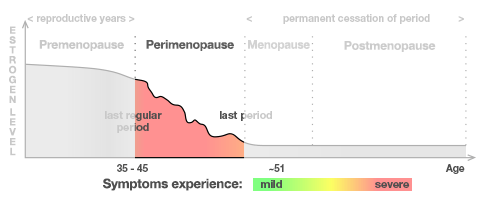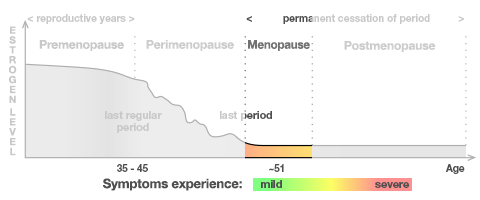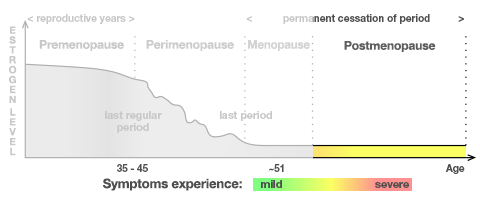
Menopause is a natural process in which menstruation ceases and a whole array of unfamiliar symptoms occurs. It is a transitional stage in a woman's life, so almost every woman entering menopause is filled with questions and concerns. SheCares is intended to answer all these questions, promoting health and wellness in a woman's life through a better understanding of menopause. Reading through Menopause-SheCares will help women to manage this “change of life” successfully.
Menopause is only one of several stages in the reproductive life of a woman. The whole menopause transition is divided into four main stages.
Stages of Menopause
Menopause means a woman's last menstrual period, which typically occurs around the age of 51 and marks the end of the fertile phase in a woman's life. The time when a woman's body is adjusting before and after this last menstrual period is divided into the four stages of menopause. The graph below shows the hormonal fluctuations and the general severity of menopause symptoms experienced during the stages of menopause. There are hormonal changes and symptoms in the years leading up to and beyond the final menstrual period in a women's life.

Premenopause
The term premenopause refers to the entirety of a woman's life from the first to her last regular menstrual period. Therefore, premenopause is best defined as a time of "normal" reproductive function in a woman leading into the stage of menopause called perimenopause.

In order to understand what happens to a woman's reproductive system as she grows older, it is helpful to review "normal" reproductive function during premenopause, which helps a woman's body to prepare for the possibility of pregnancy each month.
This "normal" reproductive function continues to 35 - 40 years of age. At the end of this period, also known as late premenopause, the ovaries gradually begin to produce less estrogen and progesterone, and consequently for the most women, the first typical symptoms of perimenopause appear. This should not be confused with early menopause which is menopause occurring before 40.
Perimenopause
Perimenopause means literally "around menopause" and is a transitional stage that lasts 2 - 10 years before complete cessation of the menstrual period. Perimenopause usually begins at 40 - 50 years of age. This stage of menopause is characterized by hormone fluctuations, which cause the typical menopause symptoms like menstrual irregularity.
Perimenopause is defined as the transitional time between the first irregular menstrual periods and a woman's final period. The "normal" menstrual cycle is directed by the hormonal balance between estrogen, progesterone, follicle stimulating hormone (FSH), and luteinizing hormone (LH). The fluctuations of these hormones cause the symptoms of perimenopause.
The follicles remaining in the ovaries of a perimenopausal woman get less sensitive to stimulation by FSH than they were during childbearing age. There will occasionally be abnormal cycles in which the follicle does not develop fully.

When a follicle does not develop properly, it secretes less estrogen, and FSH levels rise. Sufficiently low estrogen levels may fail to trigger the LH surge, which is supposed to rupture the follicle. Consequently, the egg isn't released and there will be a cycle without ovulation. This is termed an anovulatory cycle.
Because of this, progesterone cannot be released at the appropriate time and the lack of estrogen gives rise to all the familiar menopause symptoms.
In perimenopause, the number of such abnormal cycles without a mature follicle increases. Finally, there will be cycles in which no follicle develops at all.
The decline of progesterone and estrogen results in a general shortening the cycles. These irregular cycles are often the first signs that perimenopause has started.
These hormonal fluctuations vary from woman to woman, and consequently, each woman experiences perimenopause differently. It is said that a woman's menopause transition is similar to her mother's, but no woman can predict which symptoms she will experience or when she will experience them. In addition, if a woman smokes, she can count on starting perimenopause one to two years earlier than women who don't.
In summary, perimenopause can best be described as the time when a body gets ready for menopause, and many symptoms start appearing during this stage.
Perimenopause symptoms
When perimenopause starts, a woman's body experiences many changes due to the fluctuation in estrogen levels. This will lead to hormonal imbalance, producing all the symptoms of perimenopause.

The diagram above shows how estrogen levels drop dramatically during perimenopause but fluctuate all the while. The ultimate decline in estrogen results in a hormonal imbalance in a woman's body and causes the common perimenopause symptoms.
These changes can be quite different on an individual basis, but most women will experience at least one of these symptoms at certain point in their lives. Therefore, it is important to be aware that these symptoms can be effectively relieved using an appropriate hormone-balancing treatment. Click here to learn more about effective treatments for hormonal imbalance.
Menopause
Menopause represents the end stage of a natural transition in a woman's reproductive life. By the time menopause occurs, estrogen and progesterone production has decreased to permanently low levels. In menopause, the ovaries stop producing eggs, and a woman is no longer able to get pregnant naturally.
On average, menopause, also known as the "change of life," occurs by the age of 51 and can be confirmed after 12 consecutive months without menstruation. Contrary to popular use, the term menopause does not refer to the gradual process of hormonal change that results in the end of menstruation and fertility. Rather than this, menopause is the end state of that process, the permanent cessation of a woman's menstrual period. The symptoms for which menopause is known are actually part of perimenopause, the transitional stage between premenopause and menopause.
Menopause symptoms
If there is one indisputable fact about menopause-related symptoms, it's that they are highly variable - every woman experiences the symptoms of menopause in her own way.
Menopause and all its stages are not an illness, but a natural process. The symptoms of menopause are just indicators of changes. The changes menopause produces in the endocrine glands lead to hormonal imbalance, which is the root of all menopause symptoms.

As shown in the diagram above, estrogen levels fluctuate and ultimately drop dramatically during perimenopause. The decline in estrogen results in hormonal imbalance and causes the common menopause symptoms. These changes can be quite different on an individual basis, but most women will begin experiencing milder symptoms at this time.
Menopause symptoms affect about 70% of women who are approaching menopause. Almost all women notice early symptoms while still having periods. The symptoms of menopause usually last for the whole menopause transition - typically until the early or mid-fifties - but some women may experience them for the rest of their life. The most common menopause symptoms are hot flashes, vaginal dryness, night sweats, and loss of libido. Learn more about the natural treatments for menopause symptoms.
Postmenopause
Once the event of menopause has occurred, a woman is said to be in postmenopause. It is generally considered that the postmenopausal phase begins when 12 full months have passed since the last menstrual period.
Once she is in postmenopause, a woman's hormone patterns have changed significantly, because the ovaries are no longer producing estrogen or progesterone at the same levels as during the menstrual cycle. Instead, fat cells continue to produce estrogen at around 40% of previous levels. The ovaries have now begun to shrink in size but still have quite an important role in postmenopause, since some hormones continue to be produced there.
In recent years, the importance of postmenopausal health has increased, particularly in Western society, because, with a life expectancy of over 80 years, many women can expect to be postmenopausal for over one third of their lives.
From now on, a woman will be postmenopausal for the rest of her life, and it is likely that women will suffer some of the postmenopause symptoms, though they are treatable.
Symptoms of the Menopause Transition
Some symptoms of hormonal imbalance are commonly experienced in both premenopause as part of premenstrual syndrome and in perimenopause. These include:
- Mood swings. A woman's reactions can become unmotivated and unpredictable.
- Headaches. Severe episodes of headaches, commonly referred to as migraines, are produced by hormonal imbalance.
- Vaginal dryness. Loss of the natural moisture of the vagina can lead to severe discomfort.
- Breast tenderness. Breasts swell and start to feel painful and tender.
- Fatigue. This refers to the sensation of complete unexplained exhaustion.
- Irritability. Women may react differently to situations that usually don't bother them.
Other symptoms are more commonly experienced during perimenopause. These potential symptoms include, but are not limited to:
- Hot flashes. These are sensations of heat in the upper part of the body.
- Night sweats. Akin to hot flashes, these are intense sweating episodes during sleep.
- Loss of libido. Sexual desire may decrease considerably. Read about menopause and sex.
- Memory lapses. Forgetting small things like appointments becomes more common, potentially interfering with daily life.
- Weight gain. Hormonal changes affect how fat is distributed through the body.
- Irregular periods. Menstrual periods become unpredictable.
After passing through the natural process of menopause, a woman's body loses the ability to maintain estrogen levels in healthy amounts. As a result, some of the symptoms that appeared during menopause because of low estrogen will still continue for the rest of women's lives.

As shown in the diagram above, estrogen levels drop dramatically during menopause, and the body will not be able to recover balanced levels. The decline of estrogen results in a hormonal imbalance and causes the common postmenopause symptoms.
Postmenopausal health concerns
In addition to menopause symptoms related to low estrogen levels - like vaginal dryness - certain health concerns may arise during postmenopause due to both low hormone levels and natural aging. These conditions may lead to a significant reduction in quality of life for both the individuals affected and their relatives. Women can take command of these health risks by implementing changes in their lifestyle and by exploring the range of preventative options available.
- Incontinence. Urine may leak or urination may be harder to control. This is especially common in women who have given birth.
- Osteoporosis. Bones become weaker and tend to fracture more easily. This condition can be detrimental if not given the right attention. Prevention of bone loss is key.
- Heart disease. Cardiovascular problems, including heart attack, are more common in women from their fifties onwards.
Some women will experience postmenopause symptoms for the rest of their lives. Therefore, it is important to follow a hormone-balancing treatment in order to control postmenopausal symptoms. Click here to learn more about the natural treatments to cope with postmenopause symptoms.


